Table of Contents
Introduction
Have you ever wondered how businesses across the globe are efficiently managing their workforce attendance?
As organizations recognize the pivotal role of attendance management in optimizing operations, the global time and attendance software market has witnessed remarkable growth.
In 2022 alone, the market soared to USD 2.7 billion and USD 3.82 billion, setting the stage for an even more significant transformation.
Projections indicate that by 2030, the market is poised to reach an impressive USD 8.3 billion to USD 9.89 billion, boasting a compound annual growth rate (CAGR) ranging from 9.7% to 12.1%.
With such substantial advancements, businesses must navigate the suitable options and select the right attendance management system tailored to their unique needs.
In this comprehensive guide, we will delve into the key considerations and steps to empower you in making an informed decision for your organization’s attendance tracking needs.
Why Is Finding The Right Attendance Management System Essential?
In modern workplaces, the significance of an effective Attendance Management System (AMS) cannot be overstated.
As businesses evolve, so do the challenges associated with managing workforce attendance.
Here are compelling reasons why finding the right Attendance Management System is essential for companies:
- Efficiency Boost
A tailored attendance management system streamlines processes, reducing manual effort and minimizing errors. This efficiency boost translates to saved time and resources for companies.
- Cost Savings
Precision in attendance tracking minimizes the financial impact of payroll errors and helps optimize workforce management. The right system ensures accurate data, preventing unnecessary expenses.
- Regulatory Compliance
A robust attendance management system ensures companies stay compliant in an era of stringent labor laws and regulations. Avoid legal hassles and fines by automating attendance tracking according to industry standards.
- Employee Accountability
A reliable system fosters a culture of accountability. Transparently recording attendance encourages employees to adhere to schedules, promoting a disciplined work environment.
- Strategic Decision-Making
Access to real-time attendance data empowers companies to make informed decisions.
Whether it’s resource allocation or identifying productivity trends, the right attendance management system provides actionable insights for strategic planning.
Understanding Your Organization’s Needs
Assessing the Size and Structure of Your Organization
Employee Strength:
- Evaluate your organization’s current and projected number of employees, accounting for potential growth or fluctuations.
- Consider the scalability of the AMS to accommodate the workforce’s size dynamics.
Geographical Distribution:
- Examine the geographical distribution of your workforce, identifying if they are centralized, dispersed across various locations, or engaging in remote work.
- Assess whether the AMS offers features such as geo-tracking to monitor and manage attendance for remote or mobile employees effectively.
Departmental Variations:
- Identify if different departments within your organization have unique attendance tracking needs or policies.
- Ensure the selected AMS can cater to department-specific requirements, such as varying shift patterns or rules.
Read more – Importance of Attendance Tracking for Blue-collar Workers in IT Companies
Identifying Key Attendance Tracking Requirements
Attendance Policies:
- Define and document your organization’s attendance policies, including punctuality, breaks, and overtime rules.
- Verify that the AMS can be configured to enforce and adapt to these policies, ensuring organizational compliance.
Leave Management:
- Assess the complexity of your leave management system, considering factors such as accruals, approvals, and different types of leaves (sick leave, vacation, etc.).
- Confirm that the AMS seamlessly integrates with your existing leave management processes, streamlining the entire leave cycle.
Flexibility and Customization:
- Evaluate the customization needs based on specific organizational nuances, workflows, or regulatory requirements.
- Choose an AMS with high configuration flexibility, allowing tailored adjustments to meet your unique requirements.
Considering Integration With HR And Management Systems
1. HRIS Integration:
- Determine the compatibility of the AMS with your existing Human Resources Information System (HRIS).
- Ensure smooth integration to enable seamless data flow between attendance tracking and other HR functions, fostering a cohesive HR ecosystem.
2. Payroll Integration:
- Confirm compatibility with your payroll system to automate payroll processes based on accurate attendance data.
- Integration with payroll ensures accuracy, reduces manual errors, and enhances overall payroll efficiency.
3. Reporting and Analytics:
- Identify the need for comprehensive reporting and analytics capabilities to derive actionable insights.
- Ensure that the AMS provides robust reporting tools, allowing for in-depth analysis of attendance data to support strategic decision-making within the organization.
Understanding the intricate details of your organization lays the groundwork for selecting an Attendance Management System that aligns seamlessly with your unique requirements.
Features to Look for in an Attendance Management System
Let’s discuss the key features, that you must check before choosing the ideal attendance management software.
Core Attendance Tracking Features
1. Time and Attendance Monitoring:
- Real-time Clock-ins and Clock-outs:
Evaluate the system’s capacity to accurately record employee arrival and departure times in real-time, ensuring precision in attendance tracking.
- Shift Tracking:
Confirm the system’s capability to efficiently manage various shifts, accommodating the diverse work schedules prevalent within your organization.
- Overtime Calculation:
Check for automated overtime calculation features, ensuring compliance with labor regulations and tracking additional work hours efficiently.
2. Real-time Tracking and Reporting:
- Live Attendance Dashboard:
Look for an intuitive dashboard providing real-time insights into employee attendance, facilitating quick decision-making.
- Customizable Alerts:
Assess the system’s ability to generate customizable alerts for tardiness, absences, or other attendance anomalies, enabling proactive management.
- Comprehensive Reporting Tools:
Evaluate the reporting capabilities, emphasizing the generation of detailed attendance reports for in-depth analysis and strategic decision-making.
3. Biometric Authentication:
- Fingerprint or Facial Recognition:
Consider systems offering advanced biometric authentication for secure and accurate attendance tracking.
- Biometric Integration:
Verify compatibility with various biometric devices, allowing flexibility to accommodate different organizational preferences and infrastructures.
- Data Security Measures:
Ensure the implementation of robust security measures to protect biometric data, maintaining the highest levels of confidentiality.
Advanced Features for Enhanced Functionality
4. Geo-fencing and Location Tracking:
- Geo-fencing Parameters:
Assess the system’s ability to set precise geographical boundaries for attendance tracking, particularly relevant for remote or field-based employees.
- GPS Integration:
Evaluate the integration with GPS technology to provide accurate location data for attendance, ensuring reliability and precision.
- Mobile Workforce Support:
Confirm that the system caters to mobile workers, providing efficient tracking regardless of location.
5. Mobile Accessibility:
- Employee Self-Service:
Look for a mobile-friendly interface enabling employees to access and manage their attendance records, fostering engagement and autonomy.
- Mobile Clock-in/Clock-out:
Assess the support for mobile-based attendance tracking, allowing employees on the go to record their attendance seamlessly.
- Push Notifications:
Consider systems that send push notifications to employees for important attendance-related updates or reminders, enhancing communication.
6. Leave Management Integration:
- Centralized Leave Tracking:
Ensure seamless integration with leave management features for a unified employee attendance and leave tracking system.
- Automated Approval Workflows:
Verify that the system streamlines the leave approval process, reducing administrative burdens and ensuring timely responses.
- Accruals and Balances:
Check for the capability to manage and display leave accruals and balances in real-time, providing transparency to employees and administrators.
Customizable Reporting:
- Customized Reporting:
Assess the flexibility of the reporting system, allowing users to create custom reports based on specific criteria, catering to diverse reporting needs.
- Export Options:
Look for the ability to export reports in different formats (PDF, Excel), facilitating seamless sharing and further external analysis.
- Integration with Analytics Tools:
Consider systems that integrate with analytics tools for advanced data analysis and forecasting, providing valuable insights for strategic planning.
By delving into the granular details of these core attendance tracking and advanced features, you lay the foundation for selecting an Attendance Management System that not only meets your current needs but also evolves with the dynamic demands of your organization.
Budget Considerations
Upfront Costs vs. Long-Term Value
- License Fees and Implementation Costs:
Evaluate Initial Investment: Understand the upfront costs, including license fees, software acquisition, and initial implementation expenses.
- Consider Implementation Services:
Assess whether additional services, such as customization, training, and support, are bundled in or incur extra charges.
- Consider Maintenance and Support:
Account for ongoing maintenance, updates, and support fees to ascertain long-term value.
Vendor Payment Models:
- Explore Payment Plans:
Investigate whether vendors offer flexible payment plans, such as monthly subscriptions or annual contracts.
- Negotiate Pricing:
Negotiate to secure favorable pricing based on your organization’s needs and size.
Scalability and Future Expansion
- Assess Growth Compatibility:
Confirm that the chosen AMS is scalable to accommodate the potential growth of your organization.
- Flexible User Licensing:
Opt for systems with flexible user licensing that allows easy scaling up or down based on workforce changes.
- Feature Upgrades and Add-ons:
Understand Additional Costs: Inquire about the costs associated with future feature upgrades and add-ons.
Integration Costs:
- Evaluate Integration Fees:
Determine if there are additional costs for integrating the AMS with existing HR, payroll, or other systems.
- Ensure Seamless Integration:
Prioritize systems that offer seamless integration to reduce potential disruptions and additional expenses.
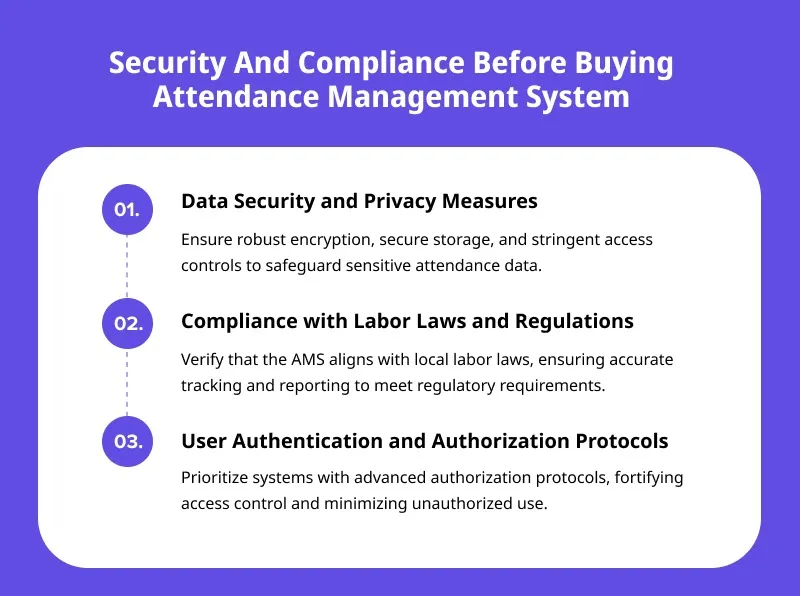
Vendor Evaluation and Selection
Selecting the optimal Attendance Management System (AMS) requires a meticulous vendor evaluation process tailored to your organization’s needs.
- Researching Potential Vendors:
Conduct thorough research on AMS vendors, emphasizing reliability and reputation. Scrutinize client testimonials for insights into attendance-specific functionalities, such as accuracy and integration capabilities.
- Request for Proposal (RFP) Process:
Craft a detailed RFP addressing specific attendance requirements: support for various tracking methods, integration capabilities, scalability, and compliance.
Seek detailed proposals, emphasizing alignment with attendance policies and reporting needs.
- Vendor Demos and Trial Periods:
Request live demos to assess AMS usability and functionality. Negotiate trial periods to evaluate practicality and compatibility in a real-world setting. Focus on how well the system adapts to unique attendance scenarios.
Choose wisely by prioritizing features and the vendor’s commitment to ongoing support and adaptability to future workforce management needs.
Workstatus: Your Best Choice for Attendance Management

The right solution is paramount for organizational efficiency in the dynamic workforce management landscape.
Workstatus emerges as an industry-leading Attendance Management System (AMS) that transcends conventional boundaries, offering a comprehensive suite of features designed to redefine how organizations track, manage, and optimize their workforce.
Features
- Attendance Management:
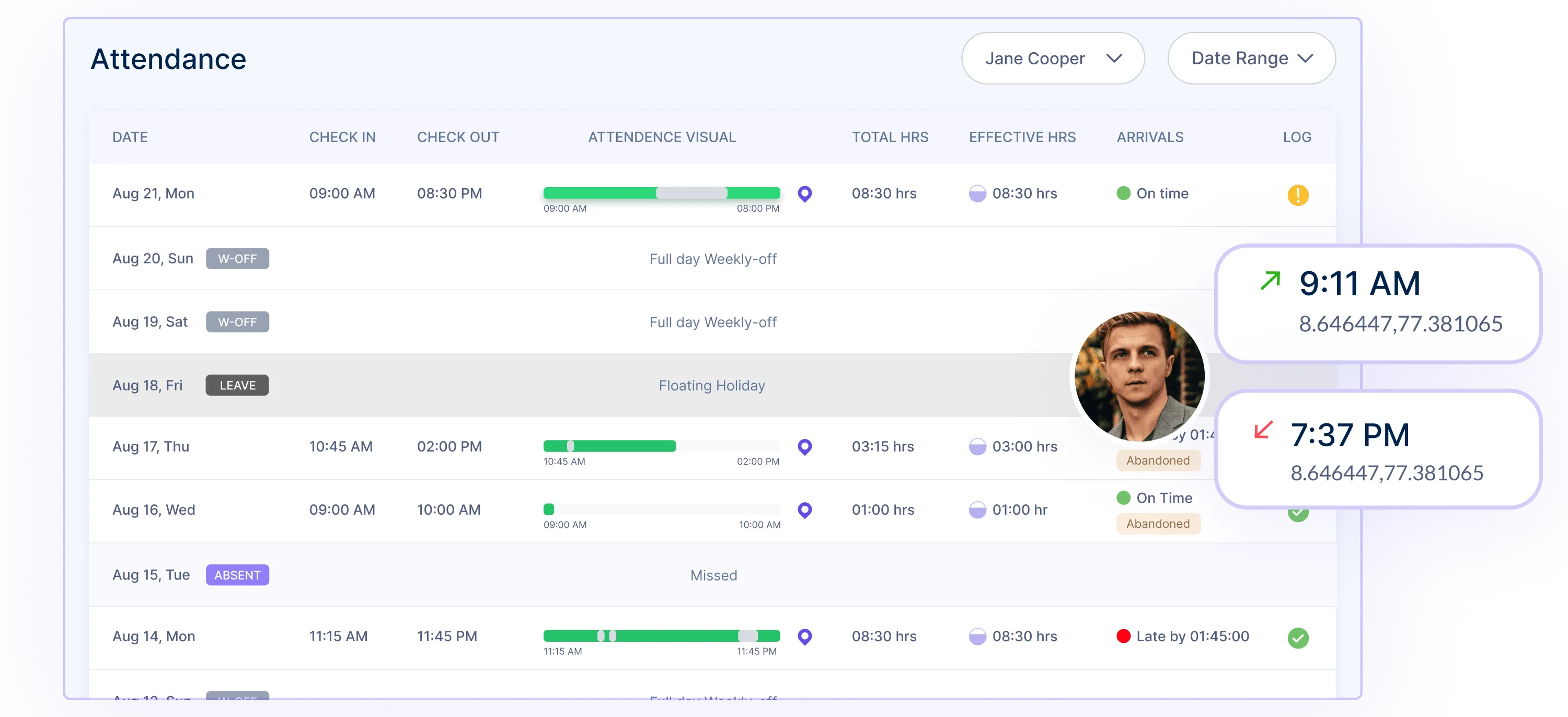
Workstatus excels in accurate attendance tracking, allowing organizations to monitor employee presence, punctuality, and adherence to work schedules.
This feature ensures precise timekeeping, aiding payroll processes and overall productivity.
- Selfie Validation:
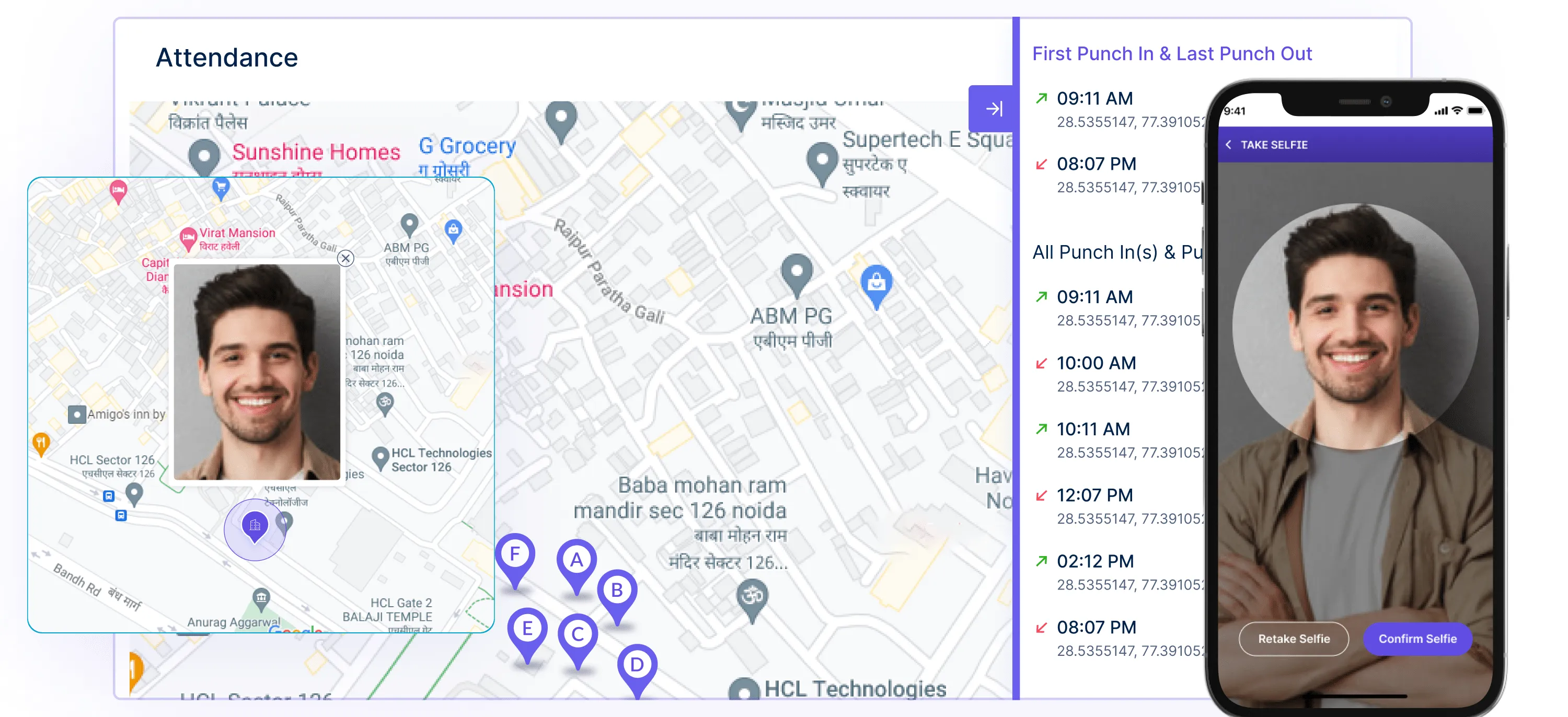
Leveraging advanced facial recognition technology, Workstatus introduces a secure and innovative Selfie Validation feature.
Employees can validate their attendance with a simple selfie, adding an extra layer of authentication to the attendance tracking process.
- Geofencing:
![]()
Workstatus incorporates Geofencing capabilities, enabling organizations to define virtual boundaries for remote work or on-the-field assignments.
This ensures that employees clock in and out within specified locations, enhancing accountability and minimizing discrepancies.
- GPS Tracking:
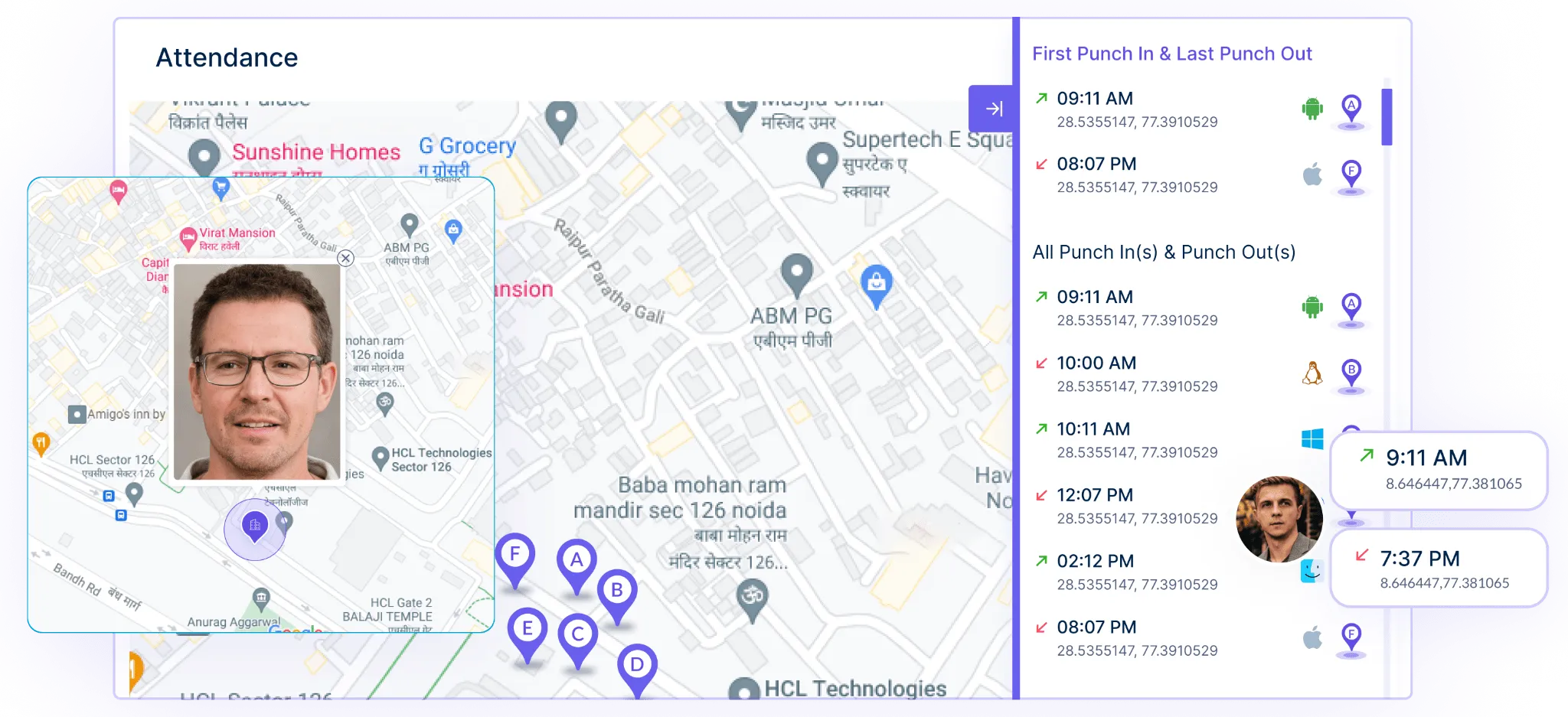
With real-time GPS tracking, Workstatus provides a detailed view of employee movements during working hours.
This feature is precious for field-based teams, enabling supervisors to optimize routes, enhance efficiency, and ensure schedule adherence.
- Mobile App:
The Workstatus mobile app empowers employees and managers alike.
Employees can conveniently mark attendance, request time off, and access personalized dashboards through the app. Managers benefit from real-time insights and efficient workforce management on the go.
- Time Off Management:
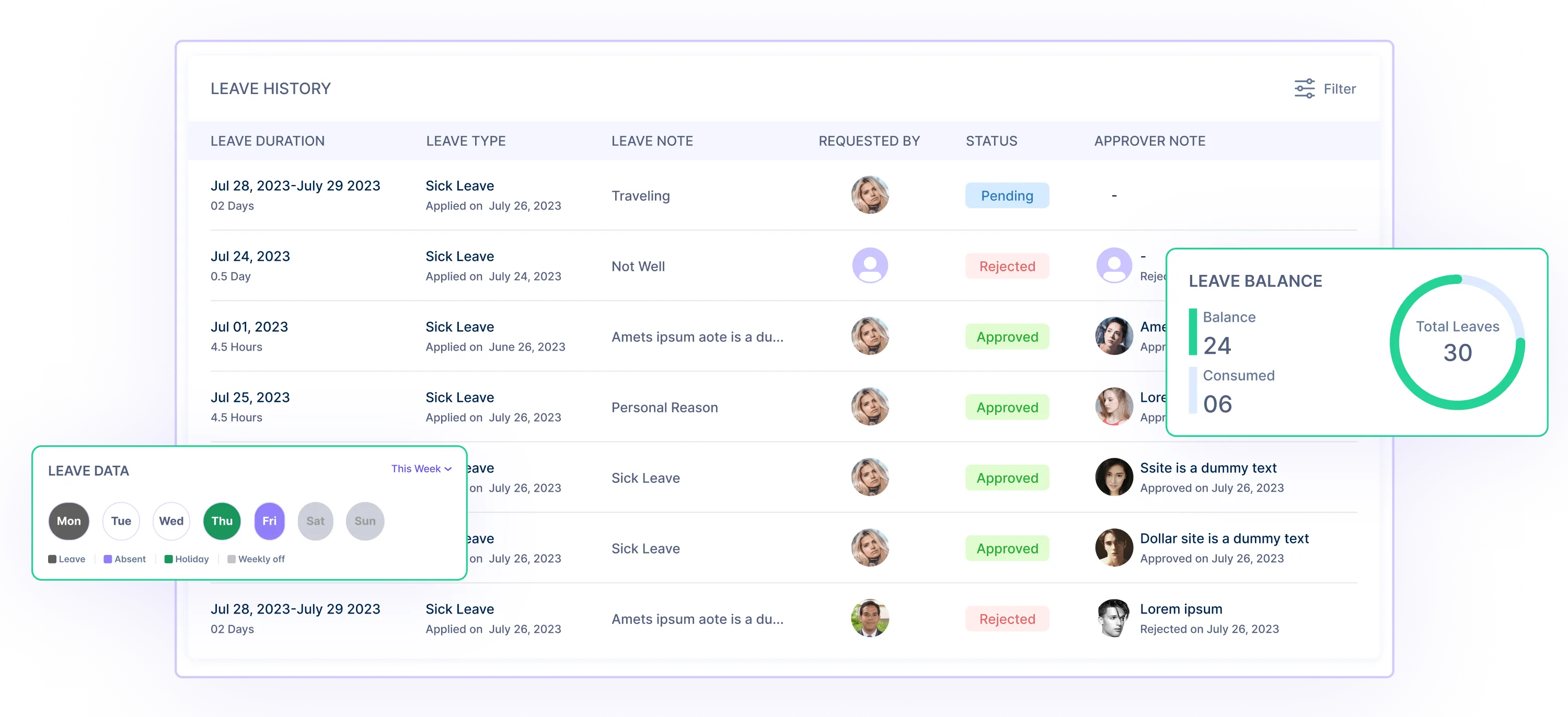
Workstatus simplifies the Time Off Management process, allowing employees to request leaves seamlessly.
The centralized system ensures managers can efficiently review and approve requests, maintaining a streamlined approach to managing absences.
- Time Tracking:
![]()
Workstatus goes a step further by incorporating Time Tracking capabilities. Employees can record project hours, facilitating accurate billing and project management.
This feature enhances transparency and accountability in time-related tasks.
- Timesheet Management:
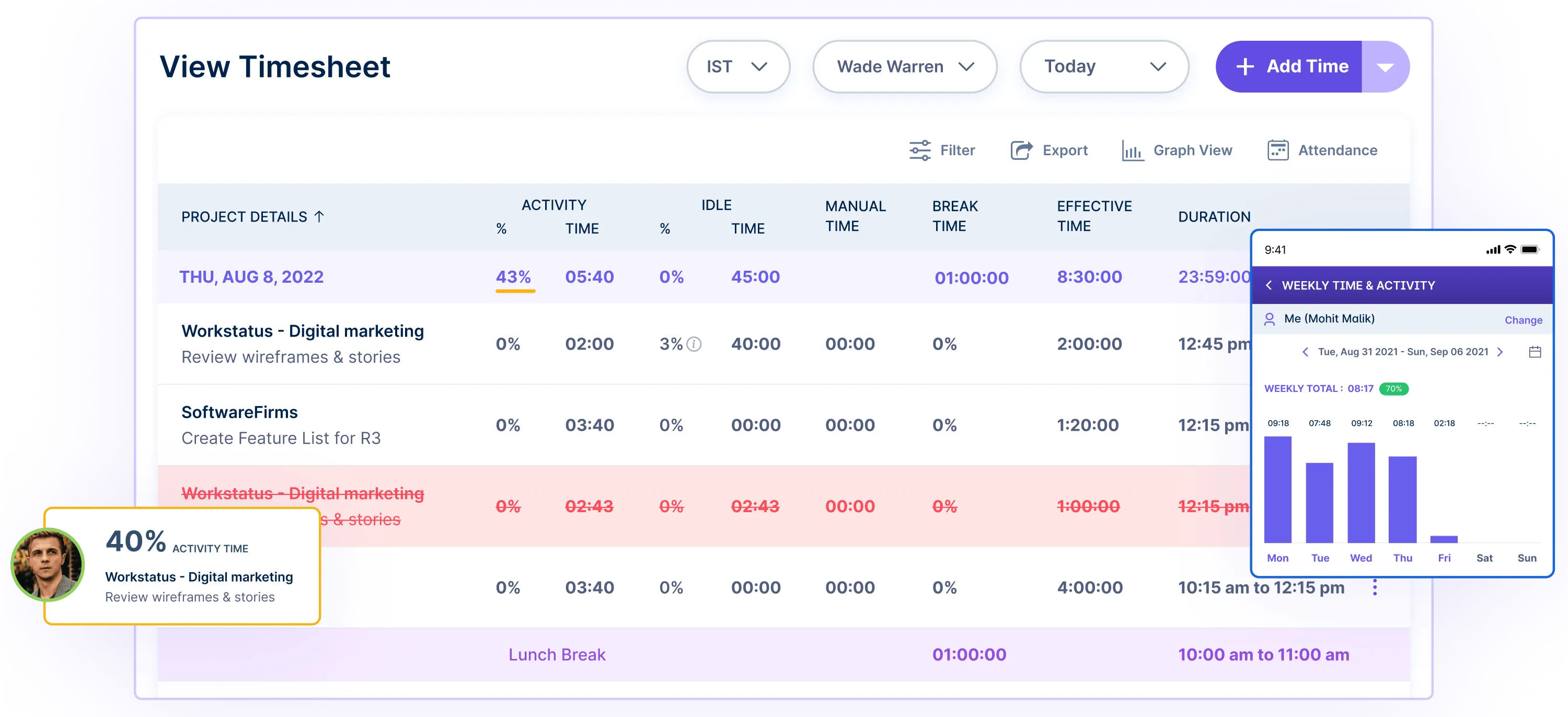
The Timesheet Management feature allows employees to submit detailed timesheets directly through the Workstatus platform.
Managers can review and approve timesheets effortlessly, streamlining the process of tracking billable hours, overtime, and project timelines.
- Workforce Optimization:
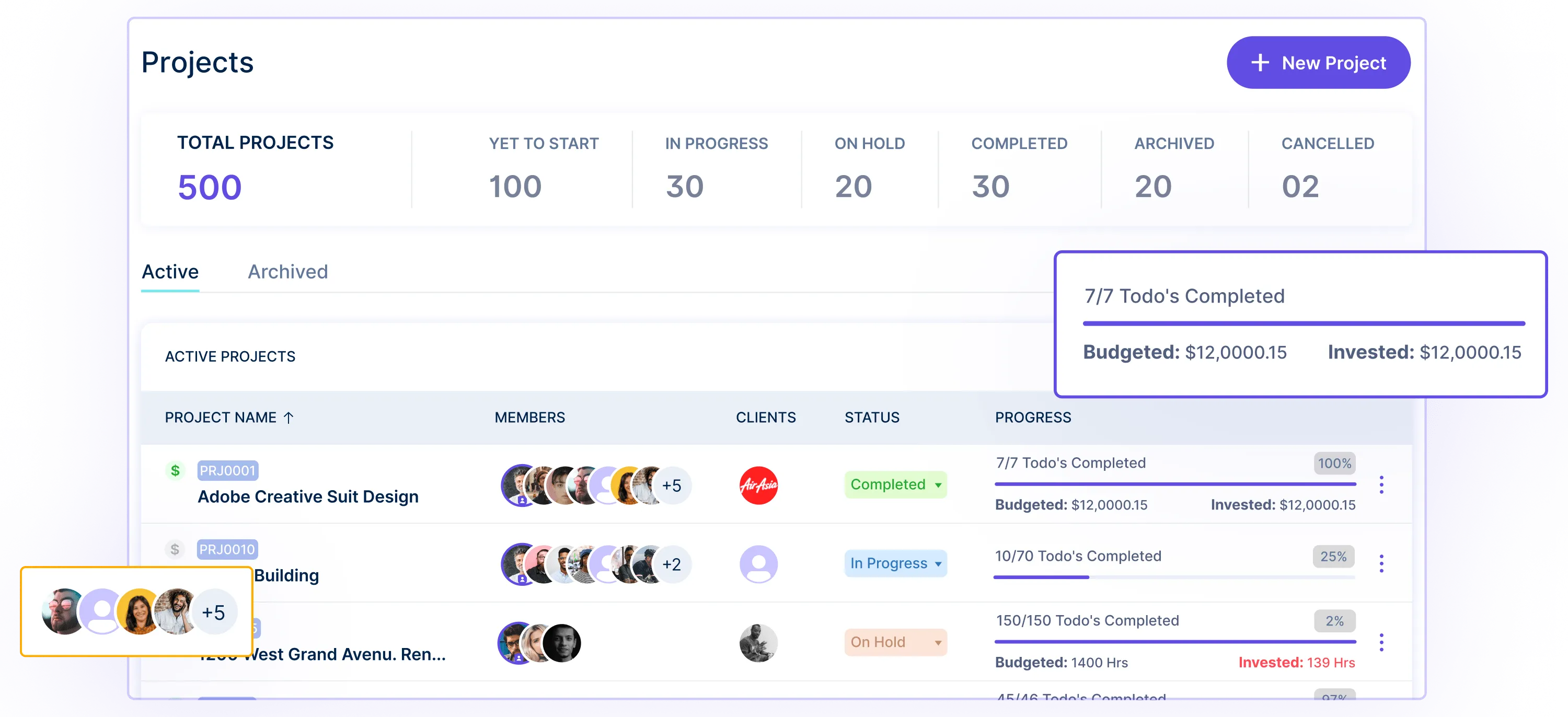
Workstatus goes beyond attendance tracking to optimize workforce management.
The system provides actionable insights for better resource allocation, scheduling, and workload distribution by analyzing attendance patterns, project hours, and timesheet data.
- Central Dashboard:

The centralized dashboard offers a holistic view of attendance data, employee activities, project hours, and key metrics. This enables quick decision-making and facilitates a proactive approach to workforce management.
- AI-Powered Reports:
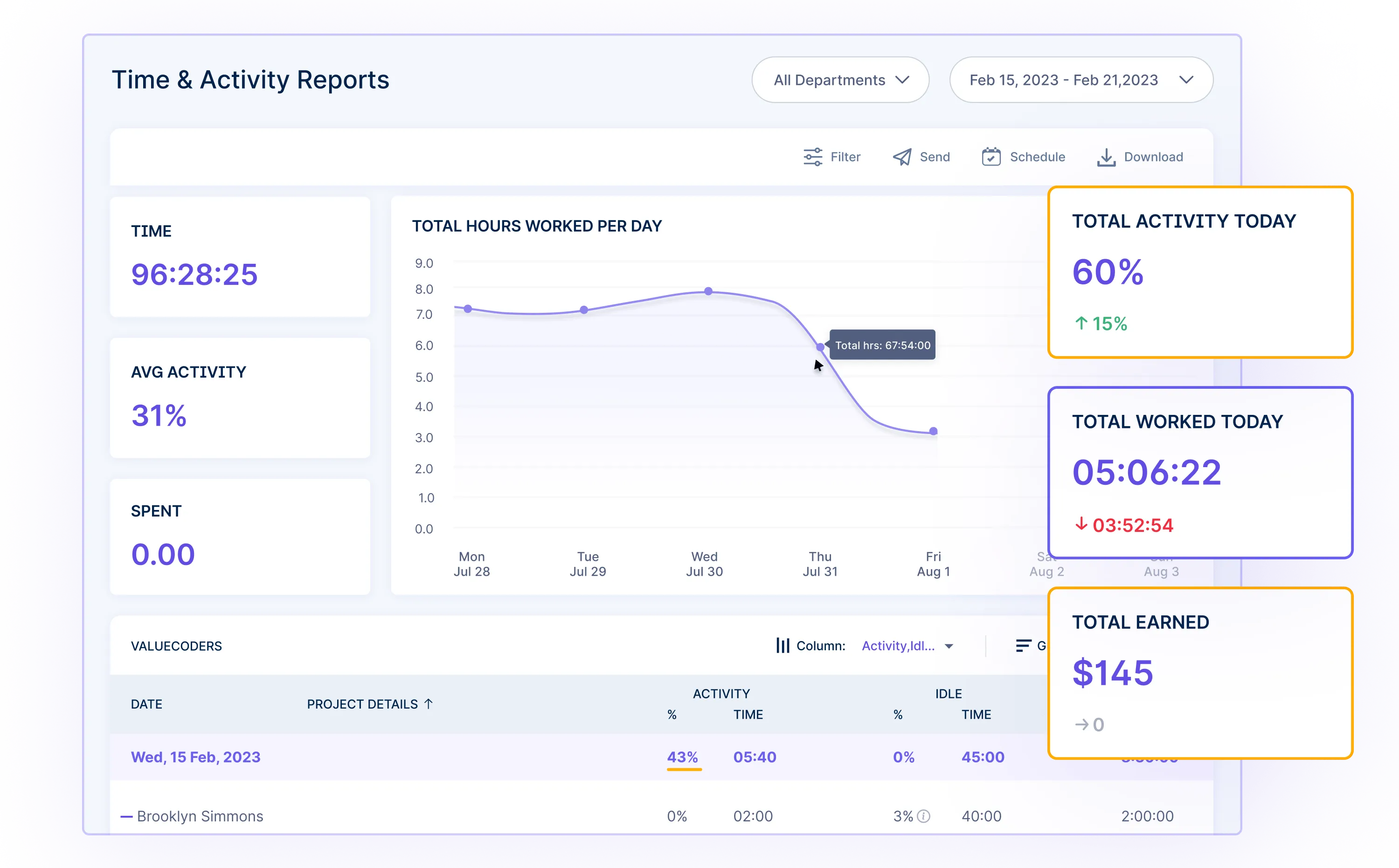
Harnessing the power of artificial intelligence, Workstatus generates insightful reports on attendance trends, employee performance, project hours, and overall workforce dynamics.
These reports aid in strategic decision-making and continuous improvement.
Workstatus: Redefining Workforce Management
What sets Workstatus apart from the crowd? Let the numbers and testimonials speak for themselves.
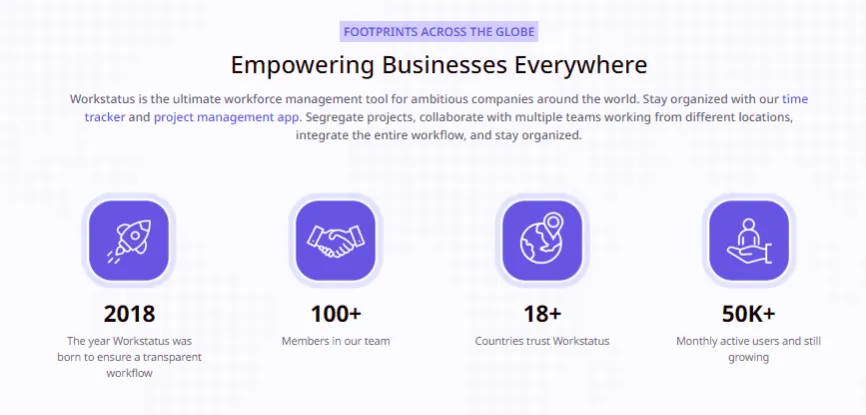
- Born in Transparency:
In 2018, Workstatus was conceived with a mission – to ensure a transparent workflow. Since then, it has evolved into a dynamic Workforce Management Solution that goes beyond mere attendance tracking.
- Team Power:
With a team of over 100 dedicated members, Workstatus brings together diverse expertise to enhance and continually innovate its platform.
This collective effort fuels the ongoing development of features that cater to the evolving needs of modern businesses.
- Global Trust:
Workstatus has earned the trust of organizations in 18+ countries, becoming a go-to solution for businesses worldwide. Its international footprint is a testament to its adaptability and effectiveness in various business environments.
- User Growth:
With over 50,000 monthly active users and a growing community, Workstatus has become an integral part of daily operations for businesses of all sizes.
Its user base continues to expand, reflecting the platform’s reliability and user-friendly experience.
- Boosted Efficiency:
Workstatus resulted in a remarkable 70% increase in overall efficiency for a multi-national marketing firm.
This statistic underscores the platform’s impact on streamlining processes and improving productivity across diverse business landscapes.
- Increased ROI:
A Delhi-based startup experienced a significant 35% increase in ROI, attributing this success to Workstatus. The platform’s ability to optimize workforce management was pivotal in achieving tangible returns on investment.
- High Ratings Across Platforms:
Workstatus boasts an impressive 4.9/5 rating on prominent review platforms such as:
- Sitejabber
- SourceForge
- GoodFirms
- SaaSHub
- Product Hunt
- Trustpilot
- SaaSworthy
These ratings are a testament to the platform’s consistent delivery of value and satisfaction to its users.
- Seamless Integrations:
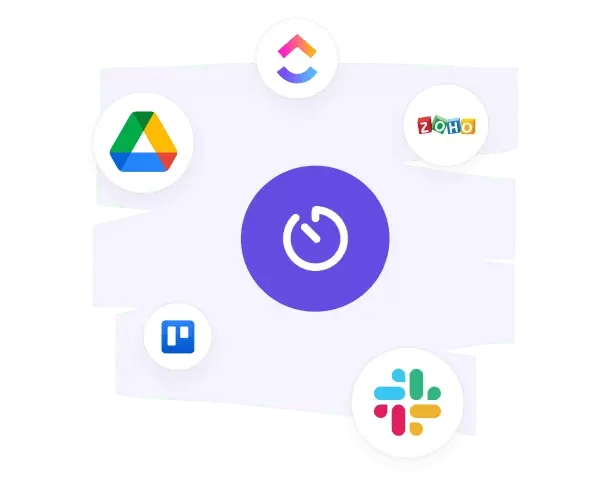
Workstatus integrates with key platforms such as Zoho, Trello, AWS, and SMTP. This adaptability ensures that our platform effortlessly integrates into your existing workflow, enhancing collaboration and efficiency.
Also read: Best Alternative to Zoho Projects
Workstatus goes beyond being a mere Attendance Management System.
It’s a transformative tool that elevates efficiency, delivers tangible results, and earns users’ trust globally.
Our commitment to innovation, coupled with the real-world impact on businesses, is what truly sets Workstatus apart from the crowd.
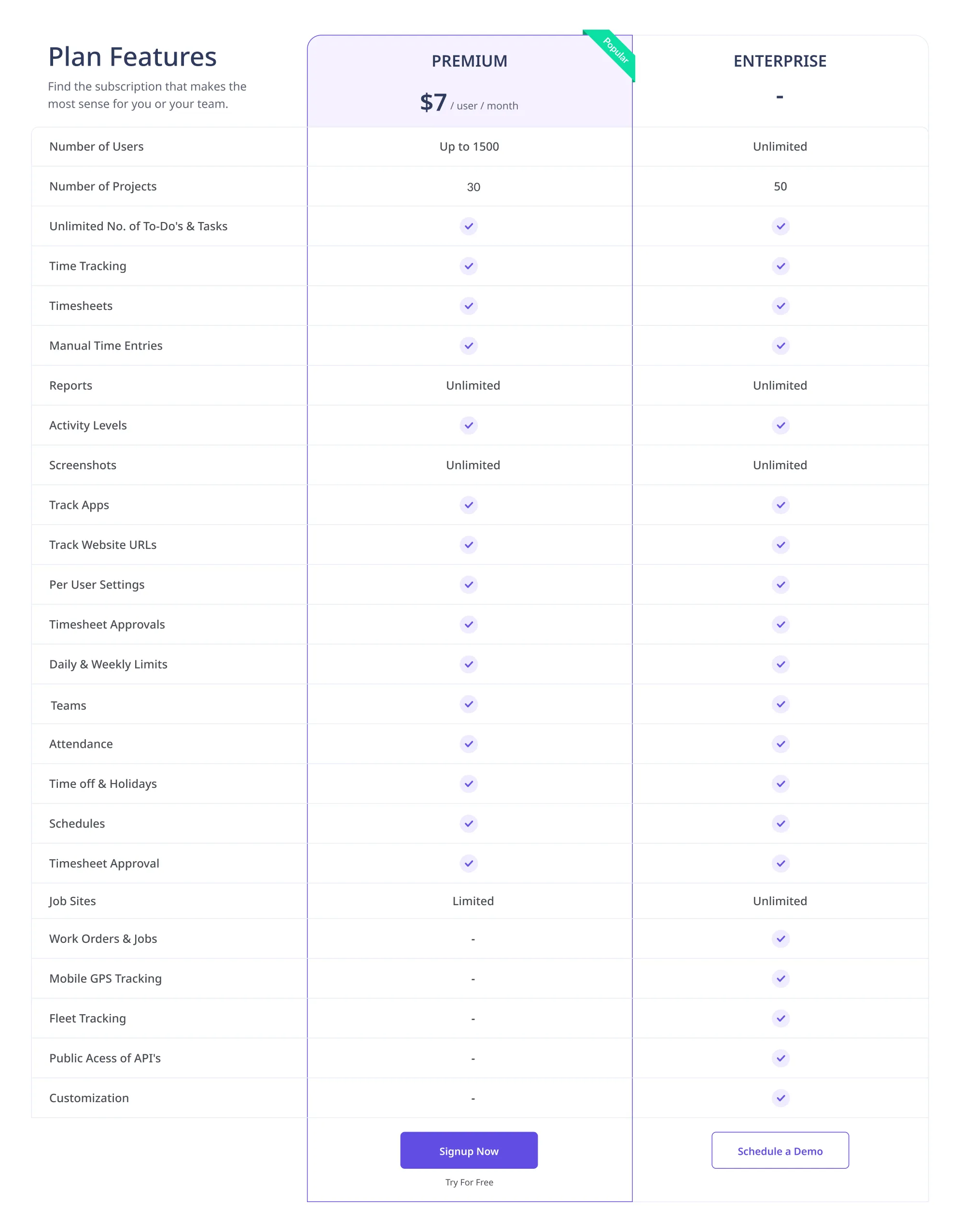
Workstatus: Tailored Solutions For Industries
As a versatile Attendance Management Solution, Workstatus caters to the distinctive needs of various industries, providing specialized features and tools to enhance efficiency and transparency.
1. IT Companies:
Workstatus ensures precise attendance tracking for IT companies, facilitating seamless integration with project management tools. It optimizes resource allocation and enhances overall productivity in dynamic IT environments.
2. Digital Agencies:
Tailored for digital agencies, Workstatus combines attendance tracking with project hours management. This integration ensures accurate billing, adherence to project timelines, and streamlined team collaboration.
3. Staffing & Recruiting:
Workstatus aids staffing and recruiting agencies manage candidate attendance during onboarding and interviews. The solution’s flexibility accommodates work arrangements and provides real-time insights for efficient resource allocation.
4. Healthcare:
In the healthcare sector, Workstatus ensures precise attendance tracking for medical staff. Its features include geofencing for field teams facilitating accurate timekeeping for healthcare professionals working in different locations.
5. eCommerce:
Workstatus enhances attendance management for eCommerce businesses, ensuring timely and efficient order processing. The solution’s integration capabilities provide valuable insights for optimizing workforce allocation during peak seasons.
6. Construction:
Designed for the construction industry, Workstatus incorporates geofencing and GPS tracking to monitor attendance on job sites. This ensures accountability, safety compliance, and efficient workforce deployment for construction projects.
7. Startups:
Workstatus is ideal for startups, offering a flexible attendance management system that adapts to the evolving needs of growing teams. The solution’s scalability supports startups as they expand and require robust workforce management tools.
8. Educational Institutions:
Workstatus caters to educational institutions, providing a comprehensive attendance management system for staff and students. The solution ensures compliance with academic schedules, simplifying attendance tracking for administrators.
Workstatus tailors its features to address specific attendance management challenges in each industry, contributing to increased efficiency, transparency, and overall workforce optimization.
With a commitment to adaptability and innovation, Workstatus empowers organizations across diverse sectors to elevate their attendance management processes.
Read More – 2024’s Top Attendance Management Tools
Workstatus: Adapting To Every Workplace Mode
Workstatus is designed to cater to the diverse workplace modes that organizations operate within, providing tailored solutions for every scenario.
1. Remote Work:
Workstatus ensures seamless attendance management and project tracking for organizations embracing remote work.
The platform’s mobile app facilitates easy clock-ins, real-time collaboration, and comprehensive insights into remote team activities.
2. Hybrid Work:
Workstatus excels in catering to hybrid work environments, where teams seamlessly transition between remote and office settings.
The platform’s geofencing and GPS tracking features maintain accountability, whether employees work from home or in the office.
3. Field Work:
Organizations with field-based teams benefit from Workstatus’s geofencing and GPS tracking functionalities.
Supervisors can optimize routes, ensure on-site attendance, and monitor project hours, contributing to enhanced efficiency and coordination in fieldwork.
4. Office Work:
Workstatus provides a centralized attendance management system for organizations with a traditional office setup.
The platform ensures accurate timekeeping, integrates with office access systems and facilitates efficient workforce management within the office environment.
Workstatus offers a tailored approach to attendance management, time tracking, and workforce optimization in each workplace mode.
Conclusion
Choosing the right Attendance Management System is pivotal for streamlined workforce operations.
This comprehensive guide emphasized meticulous vendor evaluation, industry-specific features, and adaptability to diverse workplace modes.
Amidst various options, Workstatus emerges as the ultimate solution, offering cutting-edge features, global recognition, and proven success across industries.
Elevate your attendance management with Workstatus, where innovation meets efficiency.












